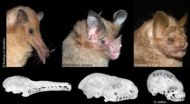(Press-News.org) Led by a group at the University of Maryland (UMd), a multi-institution team of researchers has combined modern materials research and an age-old metallurgy technique to produce an alloy that could be the basis for a new class of sensors and micromechanical devices controlled by magnetism.* The alloy, a combination of cobalt and iron, is notable, among other things, for not using rare-earth elements to achieve its properties. Materials scientists at the National Institute of Standards and Technology (NIST) contributed precision measurements of the alloy's structure and mechanical properties to the project.
The alloy exhibits a phenomenon called "giant magnetostriction," an amplified change in dimensions when placed in a sufficiently strong magnetic field. The effect is analogous to the more familiar piezoelectric effect that causes certain materials, like quartz, to compress under an electric field. They can be used in a variety of ways, including as sensitive magnetic field detectors and tiny actuators for micromechanical devices. The latter is particularly interesting to engineers because, unlike piezoelectrics, magnetostrictive elements require no wires and can be controlled by an external magnetic field source.
To find the best mixture of metals and processing, the team used a combinatorial screening technique, fabricating hundreds of tiny test cantilevers -- tiny, 10-millimeter-long, silicon beams looking like diving boards -- and coating them with a thin film of alloy, gradually varying the ratio of cobalt to iron across the array of cantilevers. They also used two different heat treatments, including, critically, one in which the alloy was heated to an annealing temperature and then suddenly quenched in water.
Quenching is a classic metallurgy technique to freeze a material's microstructure in a state that it normally only has when heated. In this case, measurements at NIST and the Stanford Synchrotron Radiation Lightsource (SSRL) showed that the best-performing alloy had a delicate hetereogenous, nanoscale structure in which cobalt-rich crystals were embedded throughout a different, iron-rich crystal structure. Magnetostriction was determined by measuring the amount by which the alloy bent the tiny silicon cantilever in a magnetic field, combined with delicate measurements at NIST to determine the stiffness of the cantilever.
The best annealed alloy showed a sizeable magnetostriction effect in magnetic fields as low as about 0.01 Tesla. (The earth's magnetic field generally ranges around roughly 0.000 045 T, and a typical ferrite refrigerator magnet might be about 0.7 T.)
The results, says team leader Ichiro Takeuchi of UMd, are lower than, but comparable to, the values for the best known magnetostrictive material, a rare-earth alloy called Tb-Dy-Fe** -- but with the advantage that the new alloy doesn't use the sometimes difficult to acquire rare earths. "Freezing in the heterogeneity by quenching is an old method in metallurgy, but our approach may be unique in thin films," he observes. "That's the beauty -- a nice, simple technique but you can get these large effects."
The quenched alloy might offer both size and processing advantages over more common piezoelectric microdevices, says NIST materials scientist Will Osborn. "Magnetorestriction devices are less developed than piezoelectrics, but they're becoming more interesting because the scale at which you can operate is smaller," he says. "Piezoelectrics are usually oxides, brittle and often lead-based, all of which is hard on manufacturing processes. These alloys are metal and much more compatible with the current generation of integrated device manufacturing. They're a good next-generation material for microelectromechanical machines."
INFORMATION:
The effort also involved researchers from the Russian Institute of Metal Physics, Urals Branch of the Academy of Science; Oregon State University and Rowan University. Funding sources included the Office of Naval Research and the National Science Foundation. SSRL is part of the SLAC National Accelerator Laboratory, operated under the auspices of the U.S. Department of Energy.
* D. Hunter, W. Osborn, K. Wang, N. Kazantseva, J. Hattrick-Simpers, R. Suchoski, R. Takahashi, M.L. Young, A. Mehta, L.A. Bendersky, S.E. Lofland, M. Wuttig and I. Takeuchi. Giant magnetostriction in annealed Co1-xFex thin-films. Nature Communications. Nov. 1, 2011. DOI: 10.1038/ncomms1529
** Terbium-dysprosium-iron.
New magnetic-field-sensitive alloy could find use in novel micromechanical devices
2011-11-24
ELSE PRESS RELEASES FROM THIS DATE:
Debt Collectors Battling State Regulations Aimed at Stopping Abuse
2011-11-24
According to the U.S. Federal Trade Commission (FTC), the number of consumer complaints against third-party debt collectors rose to 108,997 in 2010, up from about 90,000 in 2009. Federal Reserve data show that complaints rose even though consumer debt for the country overall fell to its lowest levels since 2005.
Debt collection companies have gotten more aggressive in their collection efforts in recent years. Complaints of creditor harassment have prompted many states to pass laws to regulate the industry more to prevent abuse.
In response, debt collection companies ...
Exercise helps us to eat a healthy diet
2011-11-24
A healthy diet and the right amount of exercise are key players in treating and preventing obesity but we still know little about the relationship both factors have with each other. A new study now reveals that an increase in physical activity is linked to an improvement in diet quality.
SINC
Many questions arise when trying to lose weight. Would it be better to start on a diet and then do exercise, or the other way around? And how much does one compensate the other?
"Understanding the interaction between exercise and a healthy diet could improve preventative and ...
Options for Underwater Mortgages
2011-11-24
When the economy collapsed in November 2008, many homeowners suddenly found themselves with underwater mortgages, owing more on the mortgage note than the house that secured the note was worth. As the economy continued to falter, many found it difficult to keep up with their exorbitant mortgage payments.
The residential real estate market shows few signs of significant recovery any time soon. According to RealtyTrac, a firm that records home foreclosure data, lenders foreclosed on over one million homes in 2010 alone - a record number. In Alabama, foreclosure sale listings ...
Finger (mal)formation reveals surprise function of desert DNA
2011-11-24
Scientists from the EPFL and the University of Geneva have discovered a genetic mechanism that defines the shape of our members in which, surprisingly, genes play only a secondary role. The research published in Cell, online the 23rd of November, shows the mechanism is found in a DNA sequence that was thought, incorrectly, to play no role. This long string has seven enhancers which, when combined with one another, modulate the activity of the genes responsible for the formation of the fingers – an important fundamental discovery for the field of genetics. The discovery ...
Are Many Spinal Surgeries Unnecessary?
2011-11-24
Spinal surgeries are risky procedures that require hours under anesthesia, and days of hospitalization, so no patient likely takes the decision to undergo such surgery lightly. Most are following their doctors' recommendations, but such recommendations are coming under increased scrutiny.
Chronic back pain--one of the common complaints that cause doctors to recommend spinal surgery--is one of the top 10 diseases in the US according to Forbes.com. It is also one of the most expensive: Americans spend $32 billion per year treating back pain, including spinal surgeries. ...
Genetic study confirms: First dogs came from East Asia
2011-11-24
Researchers at Sweden's KTH Royal Institute of Technology say they have found further proof that the wolf ancestors of today's domesticated dogs can be traced to southern East Asia -- findings that run counter to theories placing the cradle of the canine line in the Middle East.
Dr Peter Savolainen, KTH researcher in evolutionary genetics, says a new study released Nov. 23 confirms that an Asian region south of the Yangtze River was the principal and probably sole region where wolves were domesticated by humans.
Data on genetics, morphology and behaviour show clearly ...
Tiny levers, big moves in piezoelectric sensors
2011-11-24
VIDEO:
Animation of PMN-PT microcantilever.
Click here for more information.
A team of university researchers, aided by scientists at the National Institute of Standards and Technology (NIST), have succeeded in integrating a new, highly efficient piezoelectric material into a silicon microelectromechanical system (MEMS).* This development could lead to significant advances in sensing, imaging and energy harvesting.
A piezoelectric material, such as quartz, expands slightly when ...
Rezidor Signs Global Partnership with World Clean Up 2012
2011-11-24
Rezidor, a rapidly-expanding worldwide hotel company, has announced a partnership with World Clean Up 2012, a global campaign which aims to clean up illegal stray garbage in 100 countries and raise people's environmental awareness worldwide. Together with Carlson, majority shareholder and strategic partner of Rezidor, the company will join and support World Clean Up activities throughout the year and celebrate the end of the campaign 2012 in September during Rezidor's traditional "Responsible Business Action Month." Rezidor and Carlson are the only global partners ...
The scoop on the dangers of snow shoveling
2011-11-24
Urban legend warns shoveling snow causes heart attacks, and the legend seems all too accurate, especially for male wintery excavators with a family history of premature cardiovascular disease. However, until recently this warning was based on anecdotal reports.
Two of the most important cardiology associations in the US include snow -shoveling on their websites as a high risk physical activity, but all the citation references indicate that this warning was based one or two incidents.
"We thought that this evidence should not be enough to convince us that snow -shoveling ...
Studying bat skulls, evolutionary biologists discover how species evolve
2011-11-24
AMHERST, Mass. – A new study involving bat skulls, bite force measurements and scat samples collected by an international team of evolutionary biologists is helping to solve a nagging question of evolution: Why some groups of animals develop scores of different species over time while others evolve only a few. Their findings appear in the current issue of Proceedings of the Royal Society B: Biological Sciences.
To answer this question, Elizabeth Dumont at the University of Massachusetts Amherst and Liliana Dávalos of Stony Brook University together with colleagues at ...


